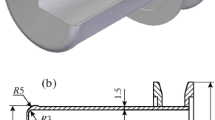Abstract
The results of experiments performed on a model of a window target of an accelerator-driven system are presented. The model, the special features of the structure, and the measurement systems and methodological approaches are briefly described. A eutectic sodium–potassium alloy is used to simulate the lead–bismuth eutectic alloy. The following characteristics were measured directly in the experiments or obtained by analyzing the experimental data: coolant flow rate, power, absolute coolant temperature as a function of distance from the target membrane, the absolute temperature of the membrane surface as a function of the distance from the membrane center, the standard deviations of the indicated quantities and the pulsations of the coolant and membrane temperatures. The measurements showed that large temperature pulsations are observed on the membrane surface; these must be taken into account when analyzing the strength characteristics of a real target setup.
Similar content being viewed by others
Author information
Authors and Affiliations
Rights and permissions
About this article
Cite this article
Efanov, A.D., Orlov, Y.I., Sorokin, A.P. et al. Thermal Experiments on a Model of a Target for an Accelerator-Driven System. Atomic Energy 93, 906–911 (2002). https://doi.org/10.1023/A:1022411805894
Issue Date:
DOI: https://doi.org/10.1023/A:1022411805894



